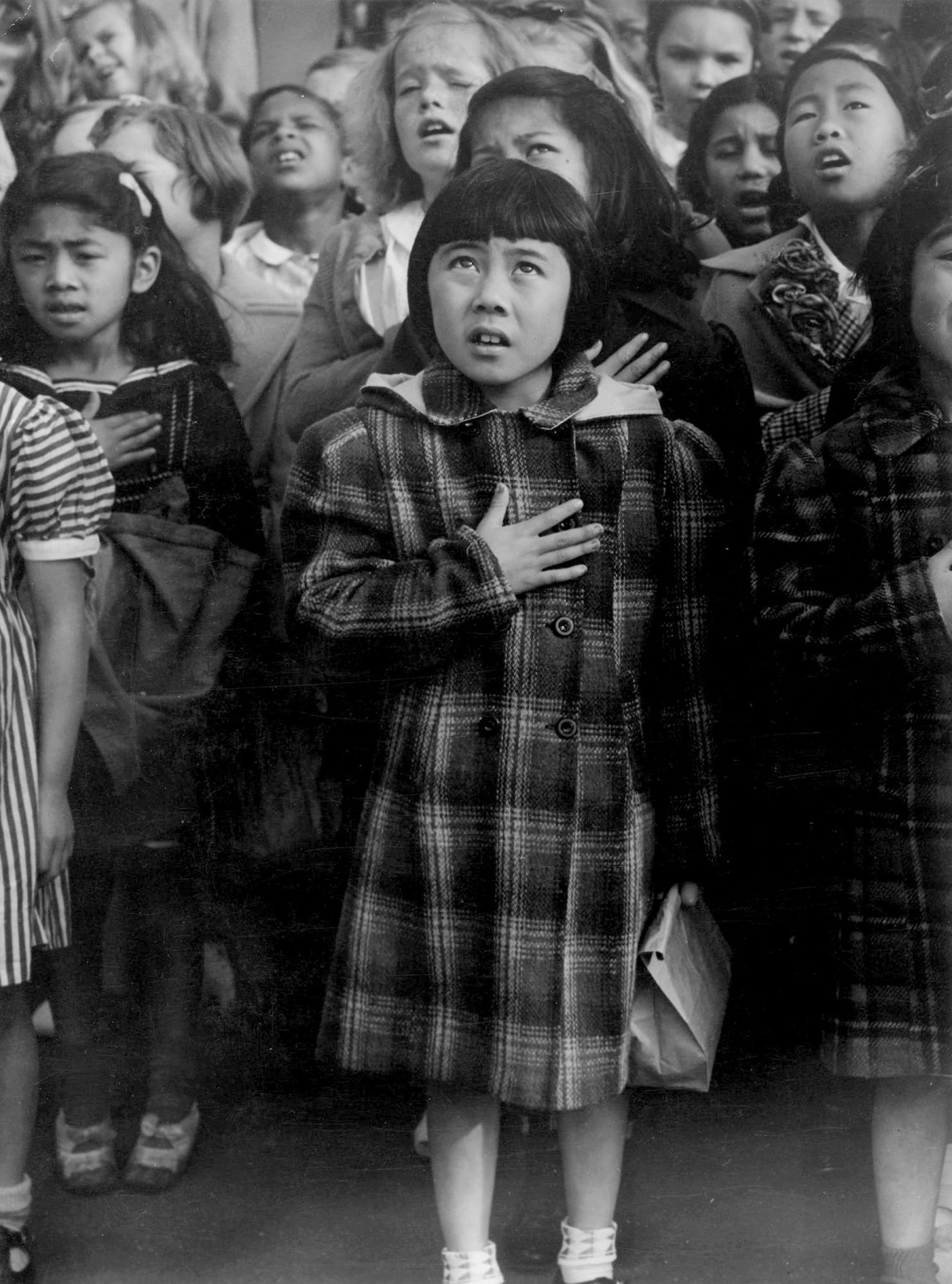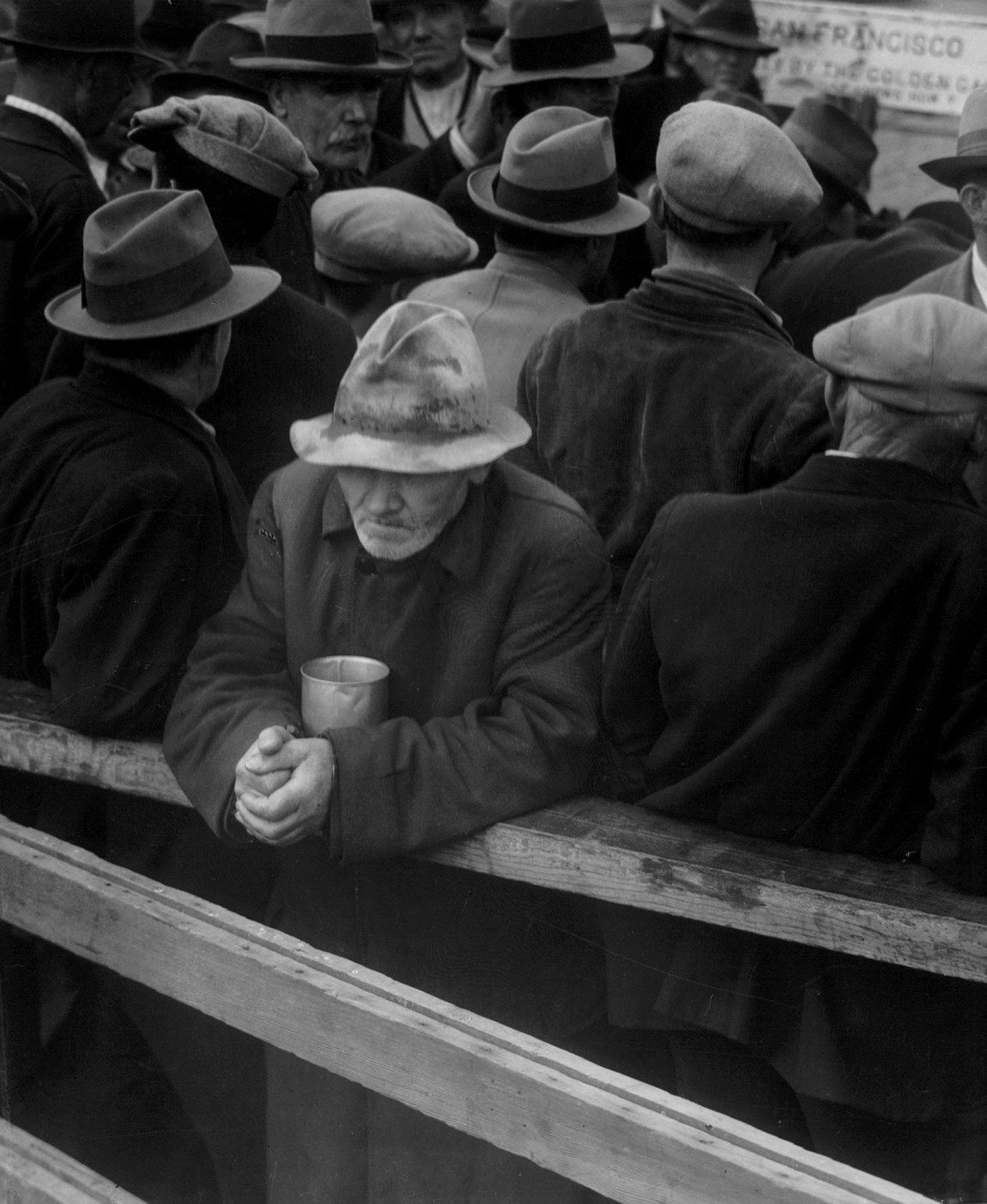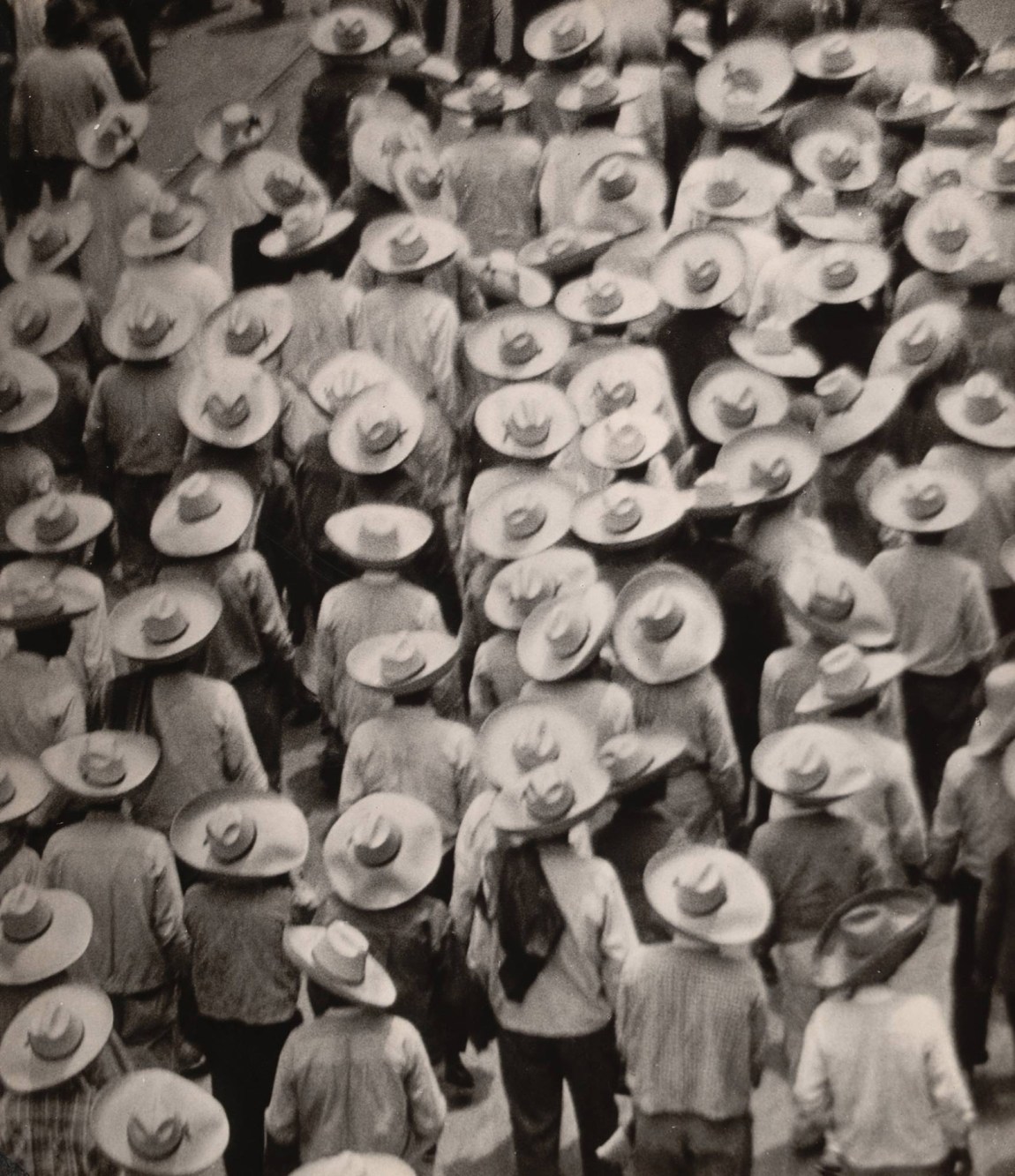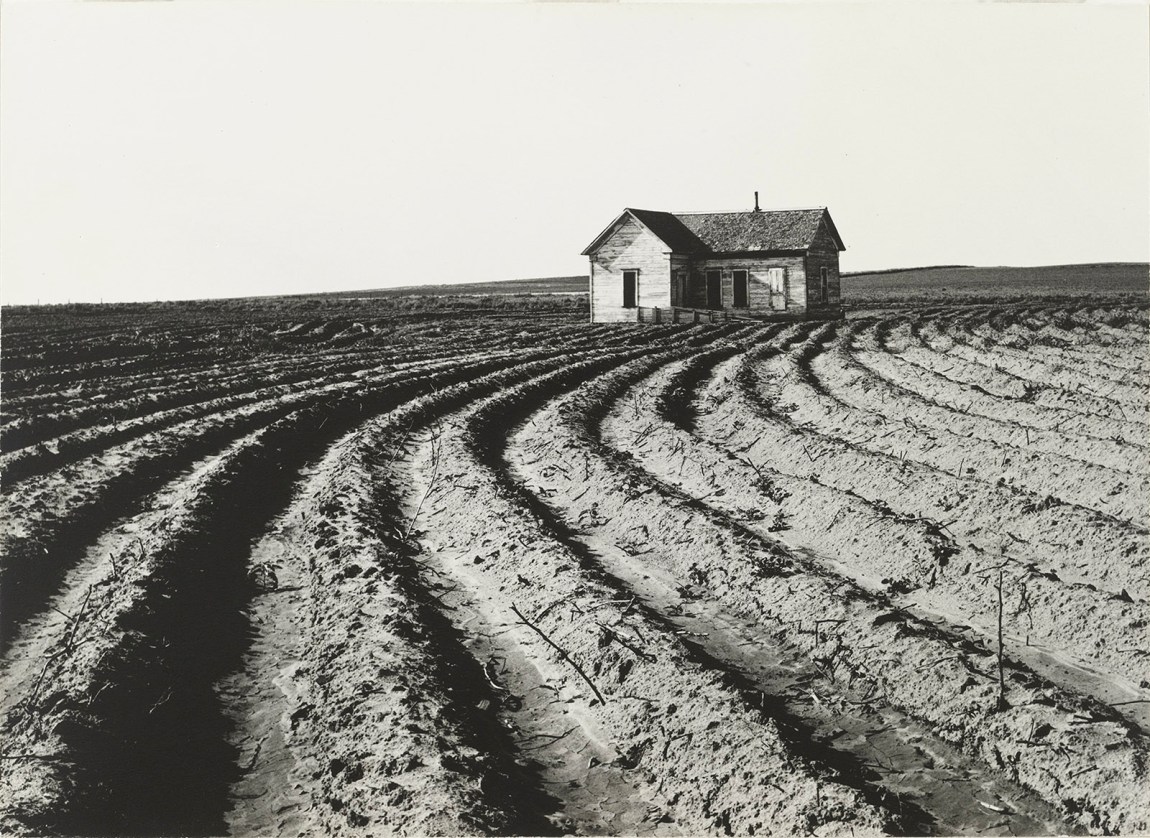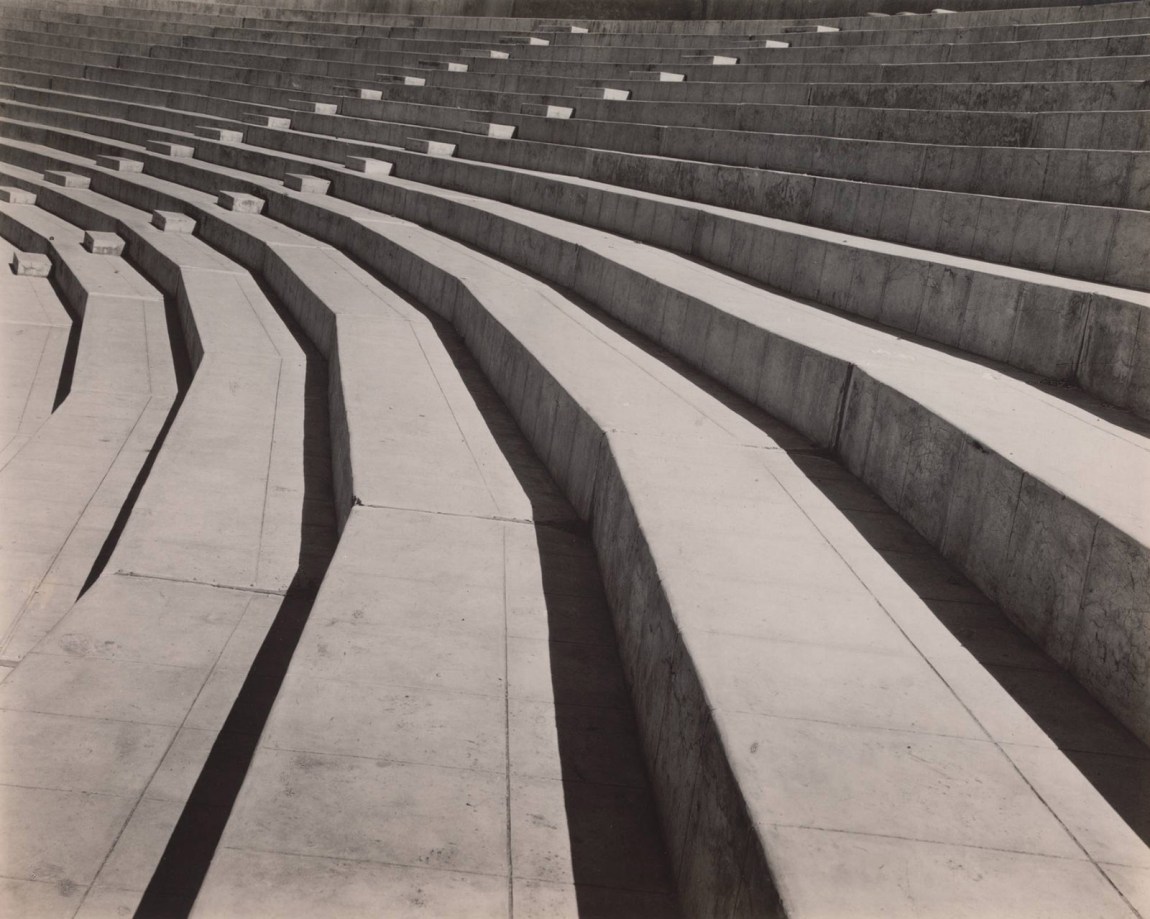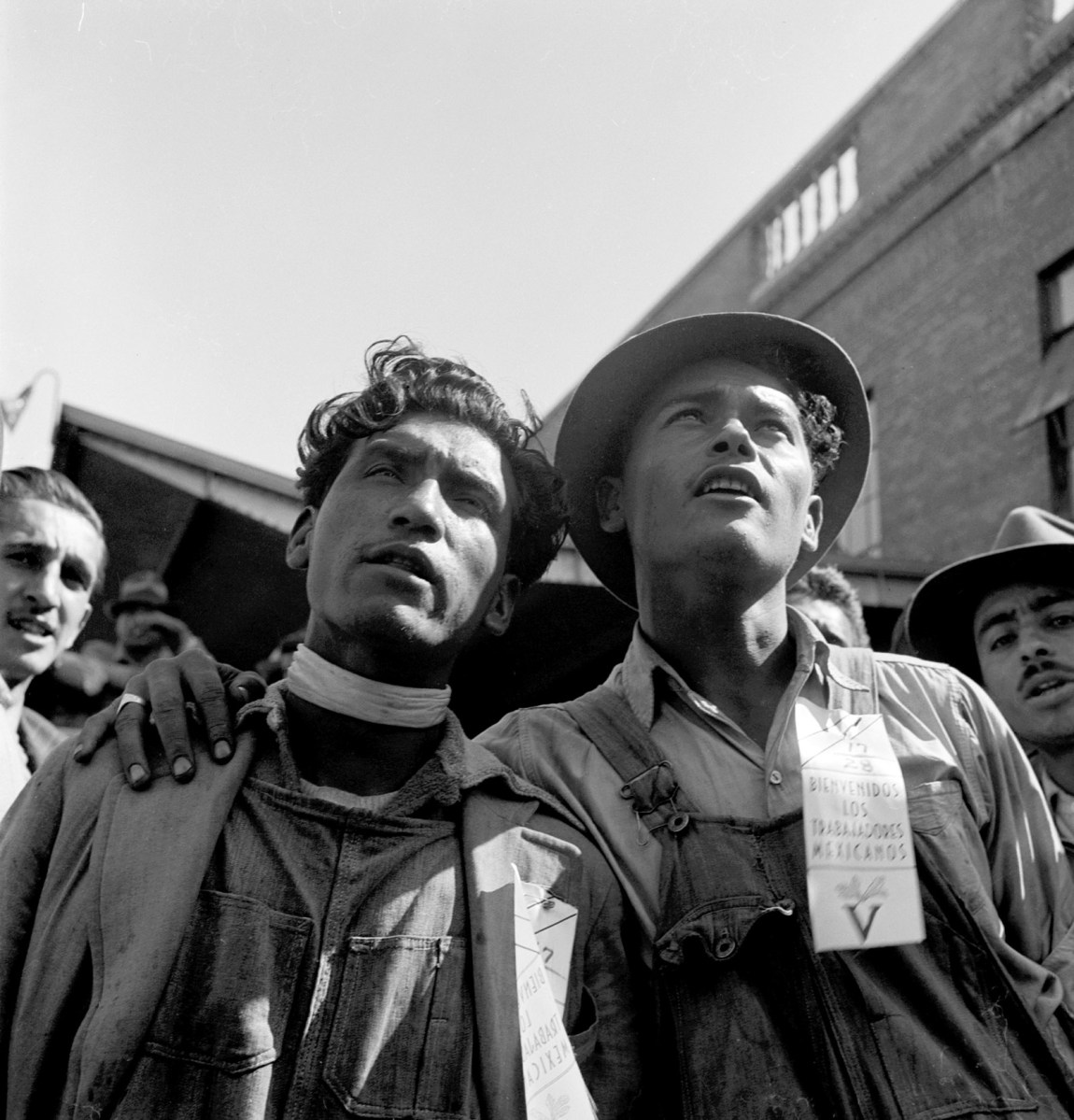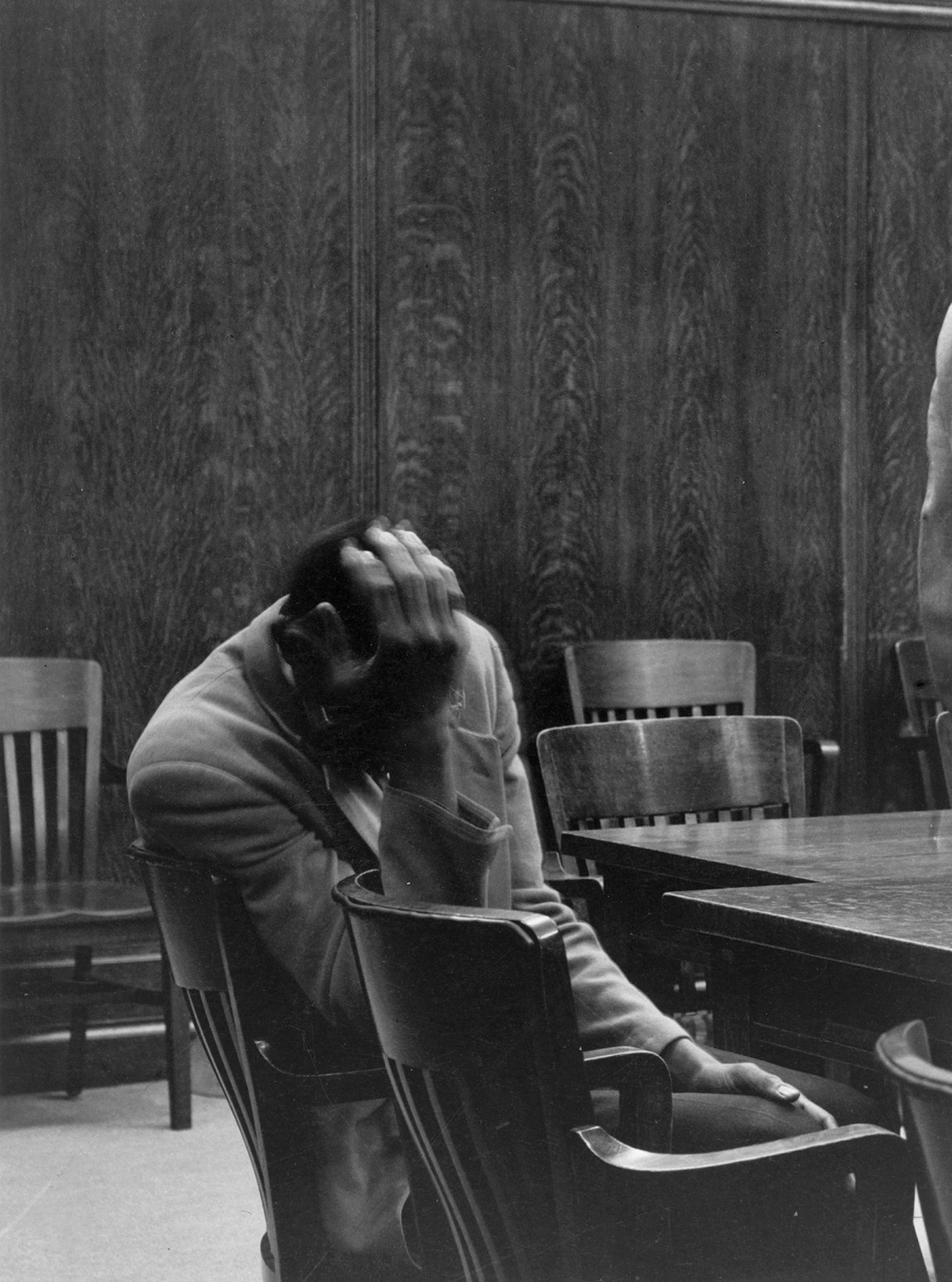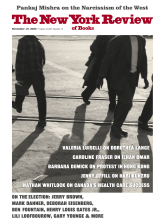In 1966 the Museum of Modern Art held a retrospective devoted to Dorothea Lange—its first-ever solo exhibition of work by a female photographer. Lange’s photographs have now become part of our collective memory of the Great Depression. Migrant Mother (1936)—a portrait taken in a pea pickers’ camp in California of a woman holding her baby and surrounded by her children—is perhaps one of the most reprinted images in history. But beyond her better-known photographs of the Depression and the Dust Bowl migrations, Lange produced a vast archive of events and crises in the American twentieth century, from the Japanese internment camps to the arrival of the first Mexican braceros and the racial and economic inequality in the judicial system. Many of those photographs were censored by the US government for decades, or simply not published by the magazines that had originally commissioned them.
When John Szarkowski, head of MoMA’s Department of Photography, initially approached her in the early 1960s, Lange was almost seventy years old and suffering from cancer of the esophagus. She had already decided to devote the time she had left to making a series of intimate family portraits, and she agreed to the retrospective with some reluctance. There is film footage of Lange talking to one of her sons in 1963, as she’s looking over a lifetime of work for the exhibition and finding herself at an impasse. Her son tells her she just needs to get the job done, to stop doubting herself and hurry up. After a short pause, she responds: “It is not really modesty on my part. Don’t mistake it. It’s not modesty. It’s that I’m afraid.”
In February 2020 the museum opened “Dorothea Lange: Words & Pictures,” curated by Sarah Hermanson Meister. As I studied Lange’s photographs in the museum in early March, just before the pandemic shut everything down, I found it difficult not to wonder: What exactly had she been afraid of? Maybe she was simply worried that she might not be able to finish her selection in time. Perhaps she thought that her work would be misunderstood, and was doubting herself the way so many women do whenever we interact with hierarchical institutions that open their doors to us only as widely as conventional narratives allow. Lange lived—we still live—in a time and a culture that hinges on the normalization of unequal standards and conditions, and then chooses exceptions to its rules, but only on its own terms. Having to embody that exception must have been a heavy honor to carry.
Or perhaps Lange’s fear was just there, as rotund and unexplainable as it is intrinsic to the creative process—that dull hum or sharp ring of fear, sometimes unleashing and at other times stifling the drive to imagine and give shape to new things. In the end, Lange agreed to choose two hundred images for the show and dedicated the next year and a half to looking through thousands of old negatives and prints, shuffling and organizing pieces of her life’s work into some kind of coherent narrative.
Dorothea Lange’s first darkroom was her mother’s repurposed chicken coop in their backyard in New Jersey, where she grew up. She was born in Hoboken in 1895 and contracted polio when she was seven. The virus left her walking with a limp for the rest of her life. She spoke about her disability, in a series of taped interviews for the California Regional Oral History Office, as “perhaps…the most important thing that happened to me, and formed me, guided me, instructed me, helped me, and humiliated me.”1 When Lange was a teenager, her mother, by then divorced and raising Lange and her brother alone, sent Lange to a girl’s high school in New York. But Lange would cut class and spend the entire day walking the city, despite the difficulties that moving about entailed. She referred to those long wanderings as not “unproductive truancy,” and believed them to be her most formative early experiences as a photographer, even though she didn’t yet own a camera. After high school, under pressure from her mother, she enrolled at Barnard to train as a teacher. She studied halfheartedly and devoted most of her time to learning photography by whatever means she found: as a camera operator, apprentice to portraitists and commercial photographers, and assistant in a number of New York studios.
In 1918, at the age of twenty-two, Lange left New York to travel the world with a friend. She planned to make a living selling her photographs, but the two young women were robbed of their savings in San Francisco and had to scramble for jobs. After a couple of months, Lange was able to rent a commercial space on Sutter Street, near Union Square, with a loan from an acquaintance she’d met at the San Francisco Camera Club. That became her second darkroom. Materials wouldn’t pay for themselves, though, so she turned part of the space into a commercial portrait studio. Clad in a Fortuny gown, she received her visitors with tea made in a Russian samovar, gradually amassing a clientele from among the city’s economic elite. She worked up to eighteen hours a day, every day, until she was able to make a living.
Advertisement
Lange’s Sutter Street studio quickly became a kind of salon where other photographers, writers, and painters gathered. Many were women, including the radical modernist Imogen Cunningham; Alma Lavenson, who photographed industrial landscapes; and Consuelo Kanaga, one of the first female photographers to document life in the South under Jim Crow, and whose portraits of black writers and intellectuals became more widely known only many years later. Some people referred to Lange’s studio as “the matrimonial bureau,” presumably because of several amorous relationships that had started at its late-night gatherings. It was there that Lange met Maynard Dixon—a cowboy-booted bohemian painter twenty years her senior. They married in 1920, only two years after she left New York, and had two sons. By the end of the decade Lange was running the studio and taking care of her children and household mostly on her own, with only intermittent participation from her husband.
During the early 1930s, the first years of the Great Depression, San Francisco’s art scene was still vibrant. Diego Rivera was painting murals at the San Francisco Art Institute, City College, and the City Club; local artists were making murals for Coit Tower; and the photographers who called themselves Group f/64—including Cunningham, Willard Van Dyke, Ansel Adams, and others—were showing their work in studios and galleries while writing manifestos in favor of “pure photography…as possessing no qualities of technique, composition or idea, derivative of any other art form.”
Lange herself never adhered to such a fixed set of aesthetic principles; she favored matter-of-factness. Around that time she pinned a note outside her darkroom—a note she later carried with her to successive darkrooms—with a quotation from Francis Bacon (the sixteenth-century philosopher, not the twentieth-century painter): “The contemplation of things as they are, without substitution or imposture, without error or confusion, is in itself a nobler thing than a whole harvest of invention.”
By 1933 there were more than 14 million unemployed people in the country. Franklin Delano Roosevelt had been elected president the previous year and set the first New Deal plans into motion, but the economy was years away from any kind of recovery. Although Lange continued to make portrait photographs in her studio, work had gotten slower and she was earning one third of her usual income. She gave up the Sutter Street studio to travel with Dixon for a while—a last, rescue-the-marriage trip—boarding their kids out with a Mormon family on weekdays.
When they returned to San Francisco they again boarded their sons (ages seven and four), this time at a school in Marin County. Lange and Dixon each took up a studio of their own on Montgomery Street. That was Lange’s third darkroom, and also where she lived for the next year. In one of her interviews for the California Regional Oral History Office, Lange describes a window in the corner of the studio where the sun came in directly. She often stood there, studying her prints, observing the street down below and the many unemployed and desperate people drifting past. It was looking out that window, she explains, that got her going “in the direction of a kind of photography for which at the time there was no name. They call it ‘documentary’ now, and though it isn’t a good name, it sticks to it.”
Lange went into the streets to take some of the first documentary photographs of the Depression, including White Angel Bread Line (1933), which shows the backs, shoulders, and hats of men waiting in line for food. One of them, an older man, is facing Lange’s camera but doesn’t look straight at it. Only his nose, unshaven chin, and downward curving lips are visible under the brim of his hat. His cracked hands are clutched together, a tin cup between his arms. The angle is slanted, as if Lange had taken the photograph while floating a few feet above the ground. The shot is reminiscent of Tina Modotti’s Workers Parade (1926), which looks from above at a group of workers during a May Day demonstration in Mexico City. Both photographs record a similar moment of political and social unrest. Modotti’s is a modernist abstraction—a constellation of hats and backs—while in Lange’s there is a deep, desolate intimacy: the hands, the cup.
Advertisement
Curiously, both photographs were on display in New York this year—Lange’s at MoMA and Modotti’s at the Whitney’s “Vida Americana” exhibition, which focuses on the influence of the Mexican muralists on US artists working for the New Deal’s Works Progress Administration (WPA) during the 1930s.2 It would be illuminating to see Modotti’s and Lange’s work on the same walls—to see, for example, Lange’s later photograph Tractored Out (1938), a shot of a lone Texan house in a field with perfectly concentric semicircles of dusty furrows yielding no crops, alongside Modotti’s Stadium, Mexico City (circa 1927), of a newly built Mexican stadium with its steps set like an amphitheater, also concentric, made of reinforced concrete. Both photographs, one rural, the other urban, register a moment of capitalism—with all its faith in mechanization and progress—that was already producing the rampant, brutal inequalities that tractored people out of their rural homes and shoved them into urban breadlines.
White Angel Bread Line was the first of Lange’s photographs to become known to a large audience. It was published in the San Francisco–based monthly magazine Camera Craft in 1934, and two years later she gave a print to the Museum of Science and Industry in Chicago. For years the print traveled to different museums and was seen by thousands or maybe millions of people. Decades later, in 2005, in a sinister irony of the market economy, this print of an elderly man waiting in a relief line sold at Sotheby’s for $822,400.
In January 1934 Lange gave up her Montgomery Street studio and sent out a change-of-address note to all her clients. The front of the leaflet said: “New Season/1934/Dorothea Lange/Photographs/of People/New Place/2515/Gough Street…” Inside, she printed the Francis Bacon quote she cherished: “The contemplation of things as they are…” Lange had changed the course of her work completely, away from commercial portraiture. Now she was mostly photographing people in the streets, where economic unease was swelling and with it political rage, fertile with possibilities.
West Coast longshoremen went on strike that May, joined later by sailors, engineers, firemen, oilers, and pilots. They demanded fair wages and hours, recognition of their union, and union control over hiring (which was, until then, done at the whim of bosses in large hiring halls). Demonstrations in San Francisco soon turned violent: the California National Guard was deployed and there was a heavy police presence. At one demonstration, police fired on strikers and killed two men.
A general strike followed, during which more than 150,000 workers shut down the city for four days. Lange documented the strike. One of her photographs shows a policeman in profile, arrogant and impassive; behind his face is a sign that reads, “Tax the rich for unemployment insurance.” Another shows a worker from the shoulders up, his eyes almost invisible under the shadow of his cap; behind him, a sign reads, “Feed us!” Still another shows a policeman standing, statue-like, hands clasped at the height of his stomach, a thumb tucked in between the buttons of his overcoat, legs in a kind of fencing stance; behind him, an orderly crowd holds up multilingual signs with anti-imperialist proclamations.
During the summer of 1934, the Group f/64 photographer Willard Van Dyke exhibited some of Lange’s photographs of the strikes and protests in his Oakland studio. It was the first time her documentary work was ever shown in a public space. Paul Taylor, a progressive agricultural economist and Berkeley professor who had done extensive work on Mexican labor in California, saw the show and was taken by Lange’s photographs. He asked her for permission to use some of them to illustrate an article he had written on the strikes for the left-wing journal Survey Graphic. A couple of months later, the two traveled with a group of photographers—including Van Dyke and Cunningham—to document the new bartering communities that the Unemployed Exchange Association (UXA) had formed across California as a response to the Depression. After a few months of collaboration, Lange and Taylor each filed for divorce from their respective spouses and started living together in San Francisco with Lange’s two sons.
In the midst of the Depression came the Dust Bowl, one of the most severe environmental crises in US history. The southern Great Plains had once been fertile grasslands, but during the long colonization of the West, farmers started deep-plowing the ground, spurred on by successive governments that offered settlers plots of land and encouraged ever more productivity and efficiency. Farmers plowed over the topsoil so frequently and fervently that they ended up displacing the region’s native grasses forever. There was nothing to hold the ground together anymore, so when droughts came and strong winds followed, enormous “black blizzards” of dust spread across parts of Kansas, Colorado, Oklahoma, Texas, and New Mexico. Thousands of families had to flee their homes.
Lange and Taylor were the first to begin photographing and interviewing the Dust Bowl migrants arriving in California. Taylor was working for the California State Emergency Relief Administration, one of Roosevelt’s early New Deal agencies, and he invited Lange to join the team. She was hired as a “typist” because the administration’s payroll had no provisions for a “documentary photographer.” I presume this would have been handled differently for a man. But Lange was in fact there to take photographs, while Taylor talked to people and took field notes. They documented the influx of rattle-trap jalopies, the stunned faces of the newly arrived families, the temporary tent settlements. The caption of a photograph that Lange took in Bakersfield, California, of a sharecropper family with their kids and belongings in tow reads, “We got blowed out in Oklahoma.”
Lange and Taylor put together a report about migratory labor that helped secure federal funding for temporary migratory camps to house displaced farm workers. Lange’s photographs were also instrumental in the creation of the Historical Section of the Farm Security Administration (FSA), a New Deal agency put together in 1937 as a response to the agricultural devastation of the Dust Bowl. After seeing Lange’s photos of the camps, Roy Stryker, the head of the Historical Section, hired a group of young photographers—Lange, Walker Evans, and Arthur Rothstein among them—who over the next few years produced a public archive of more than 80,000 photographs of the Depression.
Lange and Taylor continued to develop and perfect their method: taking photographs, interviewing, and logging field notes in a shared journal that later helped them put their work together coherently. Their respective words and photographs were not two separate projects later assembled artificially, but rather grew together, intricately woven. The culmination of their work from the 1930s was an astonishing book, An American Exodus: A Record of Human Erosion (1939)—now almost impossible to find—which assembles a narrative of human struggle against the machinery of capitalism, always swallowing labor in order to produce fortunes for the few and destitution for the many.
The book documents lives shattered by the cotton industry, rural poverty, migration to urban centers, depletion of natural resources, mechanization—and also the absurdity of it all, encapsulated in a photograph of a barbed-wire fence separating two identical expanses of dusty emptiness. The book includes introductory essays by Taylor, photographs by Lange, and captions, most of them direct quotes—fragments of conversations—from the people they approached:
There’s lots of ways to break a man down…
We’re trying not to, but we’ll be in California yet…
If you die, you’re dead—that’s all.
The people ain’t got no say a comin’.
“How do you tell others about what you think is worth telling, that you have either discovered, or uncovered, or learned…and that you think is meaningful,” Lange asks the camera in the film footage from 1963—“not moral, but meaningful?” That is, perhaps, both the most basic and complex question in the creative process: How do we organize the chaos of our individual experience into a narrative that carries collective meaning? Perhaps taking a series of photographs is similar to the process of taking notes for a novel or an essay. The hardest part comes later, when those notes have to be revised—most discarded, some kept—and then assembled into a larger narrative. And when getting that larger narrative right directly affects the people whose lives and struggles you are documenting, as was the case with Lange’s work, the responsibility is not only aesthetic but also political.
In a letter to Szarkowski from June 1965, Lange wrote:
Am working on the captions. This is not a simple, clerical matter, but a process…. They are connective tissue, and in explaining the function of the captions, as I am doing now, I believe we are extending our medium.
She was indeed extending the medium. Lange’s work from the 1930s, particularly in An American Exodus, allows us to see and almost hear the early ruins of American capitalism and the bodies it ravages. Combining images and words—where the words were the voices of the people portrayed and not the authoritative voice of the artist, curator, or editor—was a way of understanding documentary photography as a vehicle for a multiplicity of voices. In some ways, Lange’s method prefigures that of contemporary journalists like Svetlana Alexievich: there is a choral quality to her way of documenting, a collection of voices speaking in different tones and with distinct textures about a common concern.
The next decades were dramatically different for Lange. She won a Guggenheim fellowship in 1941—the first woman photographer ever to receive one—to document cooperative religious communities, but the war thwarted her plans, and she continued working for the government. The New Deal programs were fizzling out, however, and nothing like the FSA’s photographic project was repeated. In 1942 the Office of War Information was created, and it absorbed the FSA. The next year, the federal government defunded the WPA, which had employed more than eight million people to build public works.
Then, following two executive orders from Roosevelt, the government created the War Relocation Authority, the agency responsible for interning approximately 120,000 people of Japanese descent. All these bureaucratic rechristenings are enough to give a clear sense of the direction the country was about to take. The US was spinning itself out of the Great Depression by steering toward a war economy, the mass incarceration of minorities, military attacks and interventionism abroad—in other words, toward a future that is now our present.
During the next few years, Lange worked for the Office of War Information, which was openly an instrument of government propaganda, nationally and abroad. Her work was heavily surveilled and controlled, she was often accompanied by a soldier on her assignments, and all her negatives had to be sent to the government. In 1942 she photographed the first braceros—Mexican men brought into the US to work when the labor shortages of the war began. The braceros, who were called “guest workers” in the US but referred to themselves as “los enganchados” (the hooked ones), were put to work in dismal conditions, picking and canning produce on farms and building railroads. They suffered constant discrimination, and when the war was over and they were no longer needed, they were deported through a series of federal maneuvers, such as “Operation Wetback” in 1954.
Lange possibly sought to bear witness to their circumstances—the kind of approach she had been taking in her assignments for an entire decade. But the only photographs that appeared at the time are of the braceros’ arrival, showing cheerful young men smiling and waving from trains (see illustration at the bottom of page 18). These were published in 1943 in Survey Graphic with an accompanying article that claimed that “workers are being shipped from Mexico to the United States—not as unwilling forced labor, but as neighbors to help with the harvest.” It is unclear if those were indeed the only photographs that Lange was able to take, or what she may have thought of the way that, this time around, someone’s words and her pictures were paired.
After she photographed the braceros, the War Relocation Authority commissioned Lange to photograph the internment process of Japanese-Americans. She was hesitant to take the project on, but saw in it an opportunity to denounce what the government was doing. She photographed, in her own words, “baffled, bewildered people” standing in long lines in the streets, waiting for inoculations, as the government set the confinement plan into motion; then, people in front of an “ocean of desks” being interviewed—interrogated—and handed numbers in place of their family names; and, finally, people carrying their luggage and wearing their best clothes on the day of the forced relocation.
All of Lange’s negatives and prints for this project were impounded by the government. “They had wanted a record, but not a public record, and [the photographs] were not mine. I was under bond,” she said. These brutal documents of this country’s hatred toward the Japanese-American community remained mostly inaccessible until 2006, when they were all finally released.
Lange believed that a documentary photograph could only reveal something about the event it documented if it contained something larger than that event:
A documentary photograph is not a factual photograph per se. It is a photograph which carries the full meaning and significance of the episode or the circumstance or the situation that can only be revealed—because you can’t really recapture it—by this other quality.
Her photographs possess that “other quality,” and imprint themselves in the observer’s mind in such a way that they come back—an involuntary echo—when something in the world resembles them or evokes their atmosphere. In the South Texas Family Residential Center, currently the largest ICE detention center for undocumented mothers and their children, there is an eerie echo of the Manzanar Relocation Center, which Lange photographed during the Japanese internment. And therein lies not only the power but also the importance of a documentary gaze such as Lange’s: it reminds us how everything contains a trace left behind by a previous event, which will in turn continue to reverberate and ripple into the future.
In 1945 Lange stopped working for the government. The Office of War Information had asked her to photograph the first conference of the nascent United Nations, but she did not complete the task. She had become ill, and her health deteriorated over the next few years, forcing her to live with chronic pain and intermittent hospitalizations. She was less active as a photographer during the late 1940s and 1950s, though in 1952 she cofounded Aperture, the nonprofit institution and magazine devoted to photography, and worked on and off for Life magazine, often with frustrating outcomes.
One of her last large undertakings for Life, which she worked on between 1955 and 1957, was a photo-essay called “Public Defender.” In one photograph, The Defendant, a Black man sits on a chair in a courtroom, resting his face on one of his hands—an enormous, strong hand; a desperate, helpless hand. His other hand, barely visible, is tucked between his knees (see illustration on page 19). Lange, as she had done before in her work, sought to document what usually goes unseen or is willfully ignored. This time, her gaze observed racial bias against Black people in the American judicial system, and the crucial part public defenders can play in guaranteeing that those who cannot pay their way through the system get as fair a trial as possible. (It was only three years later, in 1963, that the Supreme Court ruled, in Gideon v. Wainwright, that states have to provide an attorney to defendants who cannot afford their own.)
Though some of the photographs from that series were included in the syndicated magazine This Week in 1960, Life decided not to run “Public Defender.” For almost two decades, starting in the early 1940s and into the late 1950s, Lange’s work had been surveilled, censored, misused, impounded, or simply rejected.
“Out of those materials I want to extract…the universality of the situation, not the circumstance,” Lange says on camera as she is preparing for the retrospective at MoMA in the early 1960s. Documentary photography teaches us to observe things historically, understanding the connections between systemic inequalities deeply rooted in the past, the events and crises of our present, and the possible futures that our present foreshadows. Studying Lange’s photographs today, it’s impossible not to wonder: How would she be documenting the Black Lives Matter protests and police brutality against communities of color? What photograph would she have taken in 2016—eighty years after Migrant Mother—of a migrant mother in a detention facility? How would she have captioned a photograph of children locked in one of ICE’s cages at the border? What would she have revealed to us about the lives of agricultural workers—mostly Mexican, Central American, and undocumented—feeding America through the Covid-19 pandemic while living under the threat of deportation?
Dorothea Lange died at the age of seventy in October 1965—just three and a half months before the opening of the MoMA retrospective. “Those darkroom terrors, they still remain,” she said toward the end of her life. I think of her working in her successive darkrooms: the New Jersey chicken coop; the Sutter Street “matrimonial bureau”; the Montgomery Street studio from which she looked out the window onto the Depression-ridden streets; the Gough Street studio where she developed her Dust Bowl prints; and her last studio, in the home she shared with Taylor in Oakland, where she looked back at her life’s work to put together a coherent narrative.
Perhaps Lange’s fears came from a deep consciousness of her responsibility. After documenting nearly a half-century of crises and the lives of those most deeply affected by them, Lange understood, possibly too well, the enormous responsibility that comes with telling any story, but especially the story of other people’s struggles. Fear is an embodied knowledge, an almost physical intuition of possible outcomes learned through past experience. It can spin into paranoia, paralyze us, shock us into impassivity. But it can also be a powerful drive, as I suppose it was for Lange, who with all her “darkroom terrors” was still able to document what many others had not yet seen or wanted to see. Fear allows us to give shape to things that we were unwilling to see or unable to name. Fear is a specific form of intelligence that comes when hindsight, insight, and foresight collide.
This Issue
November 19, 2020
Grand Illusions of the West
Where Health Care Is a Human Right
-
1
The interviews, collected under the title “Dorothea Lange: The Making of a Documentary Photographer,” were conducted by Suzanne Riess in 1960–1961 for the California Regional Oral History Office (now the UC Berkeley Oral History Center). Many books have drawn on them, including Linda Gordon’s Dorothea Lange: A Life Beyond Limits (Norton, 2009), Sarah Hermanson Meister’s Lange: Migrant Mother (MoMA, 2018), and Carol Quirke’s Dorothea Lange, Documentary Photography, and Twentieth-Century America: Reinventing Self and Nation (Routledge, 2019).
For more on Lange, see Jonathan Raban’s review in these pages of both Gordon’s book and Anne Whiston Spirn’s Daring to Look: Dorothea Lange’s Photographs and Reports from the Field (University of Chicago Press, 2009), November 19, 2009. ↩ -
2
“Vida Americana” remains on view at the Whitney until January 31, 2021. ↩


